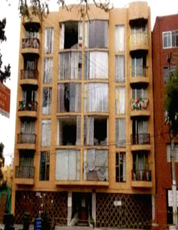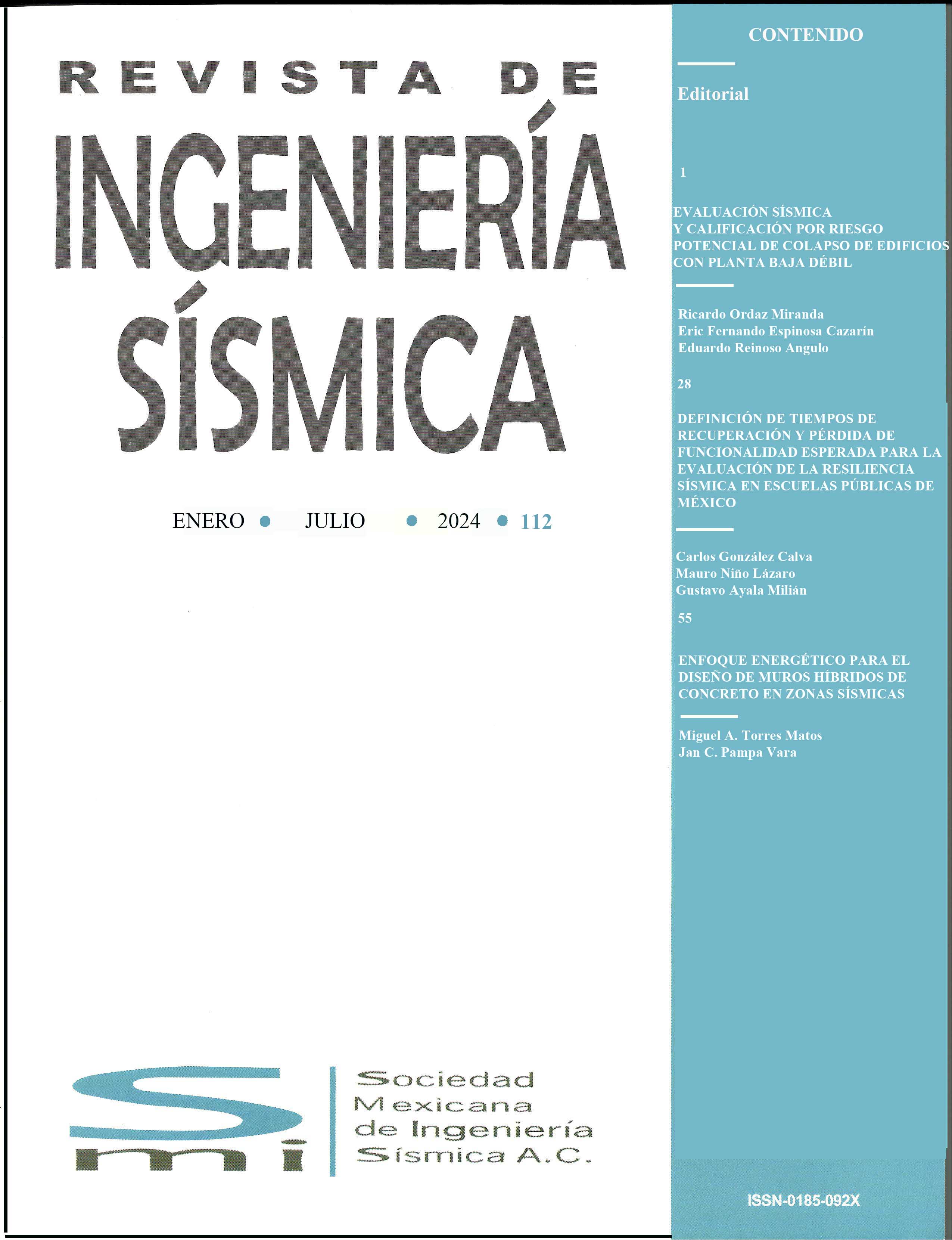FRAGILIDAD SÍSMICA DE ESTRUCTURAS DE PRIMER PISO DÉBIL CON AMORTIGUADORES DE INERCIA ROTACIONAL CON EMBRAGUE SUJETOS A EXCITACIONES SÍSMICAS DE BANDA ANGOSTA
DOI:
https://doi.org/10.18867/ris.113.639Palabras clave:
amortiguadores, inercia rotacional, embrague, primer piso débil, excitaciones sísmicas, banda angosta, fragilidad sísmica, mitigación, demanda sísmica, MéxicoResumen
Este estudio evalúa la fragilidad sísmica de estructuras de concreto reforzado (CR) de primer piso débil rehabilitadas con amortiguadores de inercia rotacional con embrague (Clutching Inerter Dampers, CID) a nivel del suelo cuando se someten a excitaciones sísmicas de banda angosta. Las principales ventajas que aportan los CID a nivel del suelo son las reducciones en las demandas sísmicas (e.g., distorsiones de entrepiso, aceleraciones de piso y cortantes de entrepiso). Este estudio muestra que las estructuras con CID llegan a ser sistemas confiables en términos de distorsiones máximas de entrepisos y aceleraciones de piso para moderados y grandes movimientos sísmicos del suelo. La tasa de daño de estructuras con amortiguadores de inercia rotacional con embrague a nivel del suelo es en general menor para edificaciones bajo intensidades sísmicas asociadas con estados límite de colapso incipiente, especialmente para edificaciones de baja altura. Los hallazgos de este estudio podrían guiar a los ingenieros de la práctica a usar amortiguadores de inercia rotacional con embrague en la rehabilitación de estructuras dúctiles de marcos de CR de primer piso débil sujetos a excitaciones sísmicas de banda angosta en zonas como la Ciudad de México.
Descargas
Citas
AIJ (1997). Report on the Hanshin-Awaji Earthquake Disaster-Building Series. In Volume 1: Structural Damage to Reinforced Concrete Building, Architectural Institute of Japan (AIJ): Tokyo, Japan1997 (en Japonés).
AIJ (2011). Preliminary Reconnaissance Report of the 2011 Tohoku-Chiho Taiheiyo-Oki Earthquake, Architectural Institute of Japan (AIJ): Tokyo, Japan, pp. 105–111 (en Japonés). DOI: 10.1007/978-4-431-54097-7.
Alam, Z., Zhang, C., Samali, B (2020). The role of viscoelastic damping on retrofitting seismic performance of asymmetric rein-forced concrete structures. Earthq. Eng. Eng. Vib., Vol. 19, pp. 223-237. DOI: 10.1007/s11803-020-0558-x
Alavi, B., Krawinkler, H. (2004a) Behavior of moment-resisting frame structures subjected to near-fault ground motions. Earthq. Eng. Struct. Dyn. Vol. 33, No. 6, pp. 687-706. DOI: 10.1002/eqe.369
Alavi, B., Krawinkler, H. (2004b) Strengthening of moment-resisting frame structures against near-fault ground motion effects. Earthq. Eng. Struct. Dyn. Vol. 33, No. 6, pp. 707-722. DOI: 10.1002/eqe.370
Arakaki, T., Kuroda, H., Arima, F., Inoue, Y., Baba, K. (1999a). Development of seismic devices applied to ball screw: Part 1 Basic performance test of RD-series. AIJ J. Technol. Des., Vol. 5, pp. 239-244. DOI: 10.3130/aijt.5.239_1
Arakaki, T. , Kuroda, H. , Arima, F. , Inoue, Y. , Baba, K. (1999b). Development of seismic devices applied to ball screw: Part 2 Performance test and evaluation of RD-series. AIJ J. Technol. Des., Vol. 5, pp. 265-270.
Bray, J. D., y Travasarou, T. (2007). Simplified procedure for estimating earthquake-induced deviatoric slope displacements. Journal of Geotechnical and Geoenvironmental Engineering, Vol. 133, No. 4, pp. 381-392
Bouc, R. (1971). Modele mathematique d’hysteresis. Acustica, Vol. 21, pp. 16-25.
Candia, G., Macedo Jaimes, M.A., Magda-Verdugo, C. (2019). A new state of the art platform for probabilistic and deterministic seismic hazard assessment. Seismol. Res. Lett., Vol. 90, No. 6, pp. 2262-2275. DOI: 10.1785/0220190025
Cardenas, Y. (2020). Comportamiento Sísmico de Edificios de Concreto Reforzado con Planta Baja Débil Sujetos al Sismo del 19 de septiembre de 2017. Tesis Licenciatura, Facultad de Ingeniería, Universidad Michoacana de San Nicolás de Hidalgo, Morelia, México.
Cornell, C.A. (1968). Engineering seismic risk analysis. Bull. Seismol. Soc. Am., Vol. 58, No. 5, pp. 1583-1606. DOI: 10.1785/BSSA0580051583
Der Kiureghian (2005). Non-Ergodicity and PEER’s framework formula. Earthq. Eng. Struct. Dyn., Vol. 34, No. 13, pp. 1643-1652. DOI: 10.1002/eqe.504
Gregorio, L. (2020). Evaluación de las Nuevas Disposiciones Normativas para el Diseño Sísmico de Edificios de Concreto Reforza-do con Planta Baja Débil. Tesis Licenciatura, School of Engineering, Universidad Michoacana de San Nicolás de Hidalgo, Morelia, México. http://bibliotecavirtual.dgb.umich.mx:8083/xmlui/handle/DGB_UMICH/7772
Goda, K., Hong, H.P., Lee, C.S. (2009). Probabilistic characteristics of seismic ductility demand of SDOF systems with Bouc-Wen hysteretic behavior. J. Earthq. Eng., Vol. 13, No. 5, pp. 600–622. DOI: 10.1080/13632460802645098
Esteva, L. (1968). Bases para la Formulación de Decisiones de Diseño Sísmico, Serie Azul 182, Instituto de Ingeniería, Universidad Nacional Autónoma de México: Ciudad de México, México. https://hdl.handle.net/20.500.14330/TES01000294559
Esteva, L. (1970). Regionalización Sísmica para Fines de Ingeniería, Serie Azul 246, Instituto de Ingeniería UNAM: Ciudad de México, México. https://aplicaciones.iingen.unam.mx/ConsultasSPII/DetallePublicacion.aspx?id=152
Galvis, F.A., Miranda, E., Heresi, P., Dávalos, H., Ruiz-García, J. (2020). Overview of collapsed buildings in Mexico City after the 19 September 2017 (Mw7. 1) earthquake. Earthq. Spectra, Vol. 36, No.2, 8755293020936694. DOI: 10.1177/8755293020936694
García-Ranz, F., Gómez, R. (1988). The Mexico Earthquake of 19 September 1985 -Seismic Design Regulations of the 1976 Mexico Building Code. Earthq. Spectra, Vol. 4, pp. 427-439.
Hall, J.F., Heaton, T.H., Halling, M.W., Wald, D.J. (1995) Near-source ground motion and its effects on flexible buildings. Earthq. Spectra 1995, Vol. 11, pp. 569-605. DOI: 10.1193/1.1585828
Hwang, J.S., Kim, J., Kim, Y.M. (2007). Rotational inertia dampers with toggle bracing for vibration control of a building structure. Eng. Struct., 29, 1201-1208. DOI: 10.1016/j.engstruct.2006.08.005
Jaimes, M.A., Reinoso, E., Ordaz, M. (2006). Comparison of methods to predict response spectra at instrumented sites given the magnitude and distance of an earthquake. J. Earthq. Eng., Vol. 10, No. 6, pp. 887-902. DOI: 10.1080/13632460609350622
Jaimes, M.A., Reinoso, E. (2006). Comparación del comportamiento de edificios en el valle de México ante sismos de subducción y de falla normal. Rev. Ing. Sísmica, No. 75, pp. 1-22.
Jaimes, M.A., Ramirez-Gaytán, A., Reinoso, E. (2015). Ground-motion prediction model from intermediate-depth intraslab earthquakes at the hill and lake-bed zones of Mexico City. J. Earthq. Eng., Vol. 19, pp. 1260–1278. DOI: 10.1080/13632469.2015.1025926
Jaimes, M.A., Lermo, J., García-Soto, A.D. (2016). Ground-motion prediction model from local earthquakes of the Mexico Basin at the hill zone of Mexico City. Bull. Seismol. Soc. Am., Vol. 106, No. 6, pp. 2532-2544. DOI: 10.1785/0120150283
Jaimes, M.A., Niño, M., Franco I., Trejo S., Godínez F., García-Soto, A.D. (2023). Seismic Risk of Weak First-Story RC Structures with Inerter Dampers Subjected to Narrow-Band Seismic Excitations. Buildings, Vol. 13 No. 4, 929. DOI: 10.3390/buildings13040929
Kent, D.C., Park, R. (1971). Flexural members with confined concrete. J. Struct. Div., Vol. 97, pp.1969-1990. DOI: 10.1061/JSDEAG.0002957
Kunnath, S.K., Mander, J.B., Fang, L. (1997). Parameter identification for degrading and pinched hysteretic structural concrete sys-tems. Eng. Struct., Vol. 19, No. 3, pp. 224-232. DOI: 10.1016/S0141-0296(96)00058-2
Lago, A., Trabucco, D., Wood, A. (2018). Damping Technologies for Tall Buildings: Theory, Design Guidance and Case Studies, Butter-worth-Heinemann: Oxford, UK. DOI: 10.1016/C2017-0-01327-7
Lazar, I.F., Neild, S.A., Wagg, D.J. (2014). Using an inerter-based device for structural vibration suppression. Earthq. Eng. Struct. Dyn. Vol. 43, pp. 1129-1147. DOI: 10.1002/eqe.2390
Makris, N., Kampas, G. (2016). Seismic protection of structures with supplemental rotational inertia. J. Eng. Mech. Vol. 142, 04016089. DOI: 10.1061/(ASCE)EM.1943-7889.0001152
Makris, N., Moghimi, G. (2019). Displacements and forces in structures with inerters when subjected to earthquakes. J. Struct. Eng, Vol. 145, No. 2, 04018260. DOI: 10.1061/(ASCE)ST.1943-541X.0002267
Málaga-Chuquitaype, C., Menendez-Vicente, C., Thiers-Moggia, R. (2019). Experimental and numerical assessment of the seismic response of steel structures with embragueed inerters. Soil Dyn. Earthq. Eng., Vol. 121, pp. 200–211. DOI: 10.1016/j.soildyn.2019.03.016
Mazzoni, S., McKenna, F., Scott, M.H., Fenves, G.L. (2006). OpenSees command language manual. Pac. Earthq. Eng. Res. Cent., Vol. 264, pp. 137–158.
McGuire, R.K. (2008). Probabilistic seismic hazard analysis: Early history. Earthq. Eng. Struct. Dyn., Vol. 37, pp. 329-338. DOI: 10.1002/eqe.765
McKenna, F. (2011). OpenSees: A framework for earthquake engineering simulation. Comput. Sci. Eng., Vol. 13, pp. 58-66. DOI: 10.1109/MCSE.2011.66
Moghimi, G., Makris, N. (2021). Seismic response of yielding structures equipped with inerters. Soil Dyn. Earthq. Eng. Vol. 141, 106474. DOI: 10.1016/j.soildyn.2020.106474
Montalvo-Arrieta, J.C., Sánchez-Sesma, F.J., Reinoso, E. (2002). A virtual reference site for the Valley of Mexico. Bull. Seismol. Soc. Am., Vol. 92, No. 5, pp. 1847-1854. DOI: 10.1785/0120010257
NTCS (2020). Technical Norms for Seismic Design. Gaceta Oficial de la Ciudad de México. 15 de diciembre 2017. Disponible en línea: https://www.smig.org.mx/archivos/NTC2017/normas-tecnicas-complementarias-reglamento-construcciones-cdmx-2017.pdf (acceso en 10 octubre 2020).
Ordaz, M., Reinoso, E., Singh, S.K., Vera, E., Jara, J.M. (1989). Espectros de Respuesta en Diversos Sitios del Valle ante Temblores Postulados en la Brecha de Guerrero. In Memorias del VIII Congreso Nacional de Ingeniería Sísmica and VII Congreso Nacional de Ingeniería Estructural, Acapulco, México, pp. A187–A198.
Ordaz, M., Reyes, C. (1999). Earthquake hazard in Mexico City: Observations versus computations. Bull. Seismol. Soc. Am., Vol. 89, pp. 1379-1383. DOI: 10.1785/BSSA0890051379
Reinoso, E., Ordaz, M. (1999). Spectral ratios for Mexico City from free-field recordings. Earthq. Spectra, Vol. 15, No. 2, pp. 273-295. DOI: 10.1193/1.1586041
Reyes, C. (1999). El Estado Límite de Servicio en el Diseño Sísmico de Edificios. Ph.D. Thesis, UNAM, Ciudad de Mexico, México. https://hdl.handle.net/20.500.14330/TES01000270872
Singh, S.K., Iglesias, A., Ordaz, M., Pérez-Campos, X., Quintanar, L. (2011). Estimation of ground motion in Mexico City from a repeat of the M∼7.0 Acambay earthquake of 1912. Bull. Seismol. Soc. Am., Vol. 101, pp. 2015–2028. DOI: 10.1785/0120100317
Singh, S.K. (1988). A study of amplification of seismic waves in the Valley of Mexico with respect to the hill zone site. Earthq. Spectra, Vol. 4, No. 4, pp. 653-674. DOI: 10.1193/1.1585496
Singh, S.K., Mena, E.A., Castro, R. (1988). Some aspects of source characteristics of the 19 September 1985 Michoacan earthquake and ground motion amplification in and near Mexico City from strong motion data. Bull. Seismol. Soc. Am. 1988, Vol 78, No. 2, pp. 451-477. DOI: 10.1785/BSSA0780020451
Smith, M.C. (2002). Synthesis of mechanical networks: The inerter. IEEE Trans. Autom. Control 2002, Vol. 47, pp. 1648-1662. DOI: 10.1109/TAC.2002.803532
Papageorgiou, C., y Smith, M. C. (2005). Laboratory experimental testing of inerters. In Proceedings of the 44th IEEE Conference on Decision and Control, pp. 3351-3356. DOI: 10.1109/CDC.2005.1582679
Patton, W.J. (1980). Mechanical Power Transmission, Prentice Hall: Upper Saddle River, NJ, USA, 1980.
Rosenblueth, E., Meli, R. (1986). The 1985 Mexico earthquake. Concr. Int., Vol. 8, pp. 23–34.
Rosenblueth, E., Arciniega, A. (1992). Response spectral ratios. Earthq. Eng. Struct. Dyn. Vol. 21, pp. 483-492. DOI: 10.1002/eqe.4290210603
Ruiz-García, J., Cárdenas, Y. (2021). Seismic performance assessment of weak first-storey RC buildings designed with old and new seismic provisions for Mexico City. Eng. Struct., Vol. 232, 111803. DOI: 10.1016/j.engstruct.2020.111803
Teran-Gilmore, A., Jirsa, J.O. (2007). Energy demands for seismic design against low-cycle fatigue. Earthq. Eng. Struct. Dyn., Vol. 36, pp. 383-404. DOI: 10.1002/eqe.663
Thiers-Moggia, R., Málaga-Chuquitaype, C. (2020). Seismic control of flexible rocking structures using inerters. Earthq. Eng. Struct. Dyn., Vol. 49, No. 14, pp. 1519-1538. DOI: 10.1002/eqe.3315
Thiers-Moggia, R., Málaga-Chuquitaype, C. (2021). Effect of base-level inerters on the higher mode response of uplifting structures. J. Eng. Mech., Vol. 147, No. 8, 04021041. DOI: 10.1061/(ASCE)EM.1943-7889.0001935
Valente, M., Milani, G. (2018). Alternative retrofitting strategies to prevent the failure of an under-designed reinforced concrete frame. Eng. Fail. Anal., Vol. 89, pp. 271-285. DOI: 10.1016/j.engfailanal.2018.02.001
Vamvatsikos, D., Cornell, C.A. (2002). Incremental dynamic analysis. Earthq. Eng. Struct. Dyn., Vol. 31, No. 3, pp. 491-514. DOI: 10.1002/eqe.141
Villaverde, R.V. (1991). Explanation for the numerous upper floor collapses during the 1985 Mexico City earthquake. Earthq. Eng. Struct. Dyn. 1991, Vol. 20, No. 3, pp. 223-2410. DOI: 10.1002/eqe.4290200303
Watson-Lamprey, J., Abrahamson, N. (2006). Selection of ground motion time series and limits on scaling. Soil Dyn. Earthq. Eng., Vol. 26, No. 5, pp. 477–482. DOI: 10.1016/j.soildyn.2005.07.001
Wen, Y.K. (1976). Method for random vibration of hysteretic systems. J. Eng. Mech. Div., Vol. 102, No. 2, pp. 249-263. DOI: 10.1061/JMCEA3.0002106

Publicado
Cómo citar
Número
Sección
Licencia
Derechos de autor 2025 Revista Ingeniería Sísmica

Esta obra está bajo una licencia internacional Creative Commons Atribución-NoComercial 4.0.






